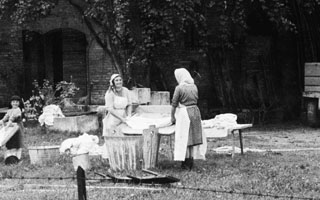Laundry

The major washing of the household linens (fèr bughè) lasted two to three days. It was done once a month and involved all the women of the family, as compatible with their chores in the fields. A detergent mixture of ashes and water (alsì) rich in potassium carbonate was used to remove filth. Ashes from “well done” embers were created and preserved for this purpose, passing them through a sieve to eliminate impurities. A large cauldron (paról) was filled with water and placed on a brick burner (furnasèla) near the well, or on a metal stove that could be moved as needed. The water was heated using wheat shafts (malghèr) and hemp roots (spruch).
Laundry was left to soak for a few hours in a large wooden tub (mastèl, mastlòn) with a first dose of detergent created by pouring ashes directly into the hot water (alsì alzira). A canvas (zindrandel) was then fastened to the edge of the tub and ashes were spread across its surface. Boling water was poured over the canvas from a pail with a long handle (mas-cla or mis-clòn), and the laundry was left to soak overnight. The following morning, a plank was balanced against the side of the tub and used as a washing board (as da lavèr). Each item was scrubbed individually with soap and a sorghum brush (brósca), then placed on a bench (banca da lavèr). The whitening process was repeated again for another night, and the entire operation was then repeated once more (alsì mórta, smóia).
At the end, the remaining detergent was allowed to flow into the water, which was then used for washing colored or wool items. The laundry was rinsed (arsintèr) in the tub using clean water from the well, or in the hemp pools, canals or water sources close to home. Finally, it was hung to dry on a long clothesline (córda da bughè).
Soap (savòn) was made, usually once a year, by boiling pork rind and bone with lye until a dense compound was formed. This mixture was then poured into a wooden box, where it would harden and compact as it dried. Small squares were cut for use during the course of the year. Soap boxes were sometimes created, with crossbeams to delineate compartments of a desired size.
Weekly washing (lavè) of daily-use items was managed by the women of each nuclear family using a smaller tub (mastlén).